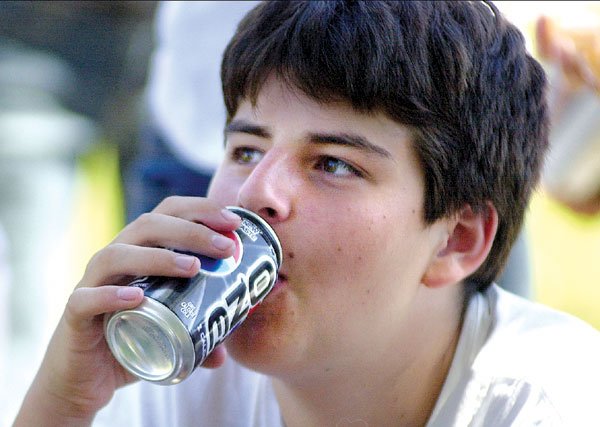You can take the soda out of the vending machines but you can’t
take the soda away from the kids
– Gilroy High School sophomore Eddie Jimenez is certain of that.
The 15-year-old brought three cans of Pepsi One to school Tuesday
despite the school’s new no-soda-sold-on-campus policy.
Gilroy – You can take the soda out of the vending machines but you can’t take the soda away from the kids – Gilroy High School sophomore Eddie Jimenez is certain of that. The 15-year-old brought three cans of Pepsi One to school Tuesday despite the school’s new no-soda-sold-on-campus policy.
“We bring them from home now that sodas are gone,” Jimenez said. “It’s like $2 for a can (of juice) – that’s just ridiculous.”
GHS vending machines are now stocked with Aquafina water, SoBe fruit drinks and Gatorade instead of soft drinks as part of a statewide initiative to limit the sale of soda on high school campuses. The legislation comes following scores of reports about the rising problem of childhood obesity throughout California, and is designed to regulate the amount of sugar in beverages sold to high school students to promote healthier eating habits.
In 2003, soda was banned from California elementary and middle schools.
“I’m delighted because I think most of us would agree that carbonation and sugar are not the best things for kids,” said Steve Brinkman, Gilroy Unified School District’s Assistant Superintendent of Educational Services.
New legislation in the state Senate and supported by Gov. Arnold Schwarzenegger would allow the sale of fruit and vegetable-based drinks that are at least half fruit juice without added sweeteners, water without sweeteners, and electrolyte replacement drinks containing no more than 42 grams of added sweetener per 20-ounce serving. Lowfat milk, rice or soy beverages are also permitted.
Just this month, the American Beverage Association instituted a new policy encouraging school districts to limit the availability of soft drinks to high school students and banning the sale to elementary students.
According to GUSD’s Food Service consultant Alane Webb, the district jumped on the health bandwagon before legislation passed to stay ahead of the game.
“The governor’s going to sign it – it’s just a matter of when,” she said.
So when students returned to GHS they did so to a new year and new vending machines.
“We haven’t had any complaints … We would have had a response the first day,” Webb said.
While students may not have formally filed a complaint, many are disgruntled over the change.
GHS junior Rachelle Struthers called the move “absurd.”
“I think people need caffeine to get through the day,” she said.
Another student pointed out the hypocrisy in the legislation.
“I think it’s fake because they still serve chili cheese fries but they take our sodas,” said GHS junior Tania Reynolds.
A self-proclaimed water drinker, Reynolds doesn’t believe students will purchase as many beverages now.
“People aren’t really juice people,” she said. “I don’t see people drinking as much now.”
But the vending machines don’t lie.
“Sold out” flashed across the Gatorade and SoBe vending screens. The 18 beverage vending machines are stocked daily.
During lunch Tuesday, only five students asked for Pepsi, said Lori Jeske who works in one of the vending carts on campus.
“We had one kid ask for a Pepsi yesterday and it wasn’t a big deal,” she said. “We’re trying to focus on a more nutritional menu … If people want to serve their kids sodas fine – but we can’t.”
In addition to sodas exiting the campus, healthier menus are being introduced at the schools. Fresh fruit and baked potato chips are being pushed instead of items such as french fries.
While many students have accepted the fact that soda is no longer a staple, some students have other plans.
“I heard a kid say today that he was going to bring a backpack full of soda and sell them,” Jeske said.
But hypothetically speaking, he might turn a better profit selling water.
Of the $70,000 made off beverage vending sales most is from water, said GHS Food Service Supervisor Jody Orneles-Canali.
“It has been the number one sell for the past four years … (Soda) doesn’t quench your thirst, and I think kids are figuring out that soda is not good for you,” Orneles-Canali said.
She is supportive of the new legislation and is hoping students who oppose the move will come around. She believes the move may even help student learning.
“They can’t learn when they’re all hyped up on caffeine – there’s no way,” she said. “It’s been a longtime coming – it’s so easy to have junk food versus good food. If it’s time for us to stop and think – I’m excited. We have an epidemic where children are overweight.”
Friday she will meet with Associated Student Body students and is hoping to form a student advisory committee to help her make food selections for healthier menus.
“I think that kids will enjoy the menu if they just give it a chance,” she said.
Many students consume both breakfast and lunch at school, and school officials are hoping that the changes will have a positive affect over time.
With more education about healthier food choices, Orneles-Canali believes children will enter high school with different attitudes.
But some already agree with the policy.
“I think it’s good. It would help the school a lot – because obesity is a problem,” said senior Raul Lerma. “No matter what we say it’s not going to change anything. It’s not going to stop people from drinking soda. It just changes the way we eat at school.”
Kristen Munson covers education for the Dispatch. Reach her at 847-7097 or at km*****@************ch.com.















